#spotted lanternflies
Text
How to Identify Spotted Lanternflies
Click here to learn more about the How to Identify article series.
Name: Spotted lanternfly (Lycorma deliculata)
Range and typical habitat(s): Native range includes China and Japan; is invasive in North America and South Korea
Distinguishing physical characteristics (size, colors, overall shapes, detail shapes) and behaviors: The spotted lanternfly is a distinctive looking insect at any stage of development. The nymphs/instars have round, black bodies that taper to a small head with two large, round, yellowish eyes, one on either side. Younger instars have white spots, while the fourth and final instar additionally features bright red patches on its body. They do not have wings.
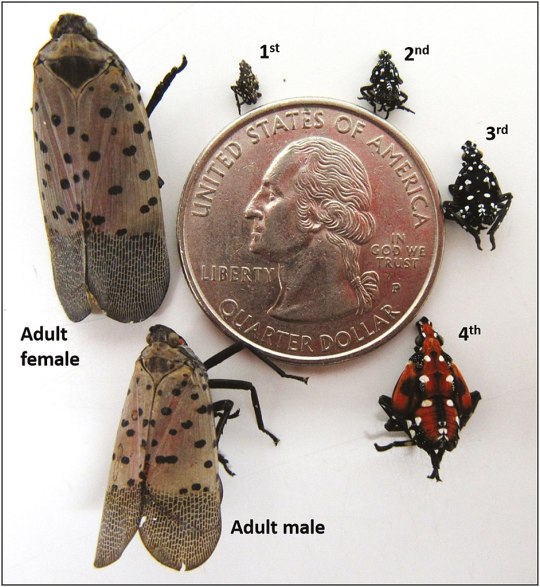
The adult spotted lanternfly is about an inch long, and is tan to light grayish-brown with a dark head and legs, and a dark triangle on the shoulders. The forewings also feature dark spots, and a dark web-like pattern at the wingtips, which are rounded in shape. The hindwings are often cover when the insect is at rest, but when spread they display bright red patches with black spots, and the distal ends are black with a white horizontal bar across each. The abdomen is thick and has yellow stripes, and the tip of the abdomen is red. The head is comparatively small, and again has two yellowish round eyes. In spite of having wings, they do not properly fly. Instead, they use these wings to help them leap from one plant to another.
The nymphs usually hatch in April or May. By July, the first adults appear, and prepare to mate and lay eggs. One female can lay up to fifty eggs that are protected in a waxy casing; they look a bit like a clump of clay or dirt stuck to a tree, wall, or other surface. They will overwinter in that spot, and in fact the colder the temperatures the more eggs hatch the following spring. The adults, meanwhile, usually die off by the end of the year; a lanternfly that has reached one year in age is geriatric indeed.

Spotted lanternflies are herbivorous; the nymphs prefer the tree of heaven (Ailanthus altissima), but will also opportunistically feed on other plants, ranging from trees to grapevines to soybeans. The nymphs and adults both suck sap from their host tree using specialized mouthparts, and in sufficient numbers can be deadly to the plant. All told, spotted lanternflies have been observed feeding on the better part of two hundred plant species.
Other organisms it could be confused with and how to tell the difference: There are two other species in the genus Lycorma that look quite similar to L. deliculata; both are found solely in Asia. L. imperialis, found in China, India, and Bangladesh, looks almost identical to L. deliculata, except the base color of the forewings in adults tends to be darker and greener in tone than the grayish-brown seen in L. deliculata. The coloration on L. imperialis’ abdomen may also vary, with orange or red patches being common.

L. imperialis. Photo by Tanja Popp, CCA-SA-4.0-Intl
L. meliae is more obviously a different species than L. deliculata. Its forewings are a deep red with the same black spots and webbing pattern. There is also a variant that is solid black except for white spots on the forewings, with a deep red to orange abdomen with black stripes or splotches. L. meliae is only found in Taiwan.

L. meliae. Photo by Lin Sun-Fong, CC BY-SA 2.0
Anything else worth mentioning? Spotted lanternflies are considered to be a highly invasive insect in North America; they arrived by accident in 2014 and have been spreading throughout the northeast since then. They do significant damage to crops such as soybeans (Glycine max) and apples (Malus domestica), and also attack native plants like black walnut (Juglans nigra) and Virginia creeper (Parthenocissus quinquefolia). The nymphs parasitize the tree in such large numbers that they can cause severe damage in a short period of time. Additionally, leaking sap from the tree as well as the nymphs’ waste (honeydew) not only drip onto the plants’ leaves and hinder photosynthesis, but they also promote fungal growth that further injures the plant.
In its native range, the spotted lanternfly’s usual host is the tree of heaven. Like the lanternfly, this tree is also highly invasive in North America, and has been a key factor facilitating the spread of spotted lanternflies. Many efforts to control or prevent the spread of lanterflies involve removing tree of heaven, which can be quite difficult to eliminate completely. However, evidence is growing that lanternfly nymphs that feed on plants other than tree of heaven are not as healthy, and this may be a crucial control in keeping these insects in check.
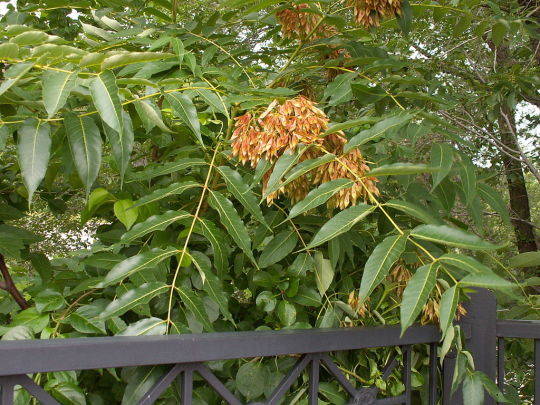
People in North America who find the nymphs or adults, and especially egg casings, are encouraged to smash them on sight. Other regions around the world that regularly trade agricultural products with China or North American countries are also on the lookout for any sign of spotted lanternflies being introduced.
Further Reading:
USDA APHIS: Spotted Lanternfly
PennState Extension: Spotted Lanternfly
Invasive Bug Prompts Quarantine In Pennsylvania Townships
Spotted Lanternfly in New Jersey: What you need to know
Spotted Lanternfly (Hemiptera: Fulgoridae) Can Complete Development and Reproduce Without Access to the Preferred Host, Ailanthus altissima
Did you enjoy this post? Consider taking one of my online foraging and natural history classes or hiring me for a guided nature tour, checking out my other articles, or picking up a paperback or ebook I’ve written! You can even buy me a coffee here!
#spotted lanternflies#spotted lanternfly#insects#invertebrates#invasive species#nature#wildlife#animals#invasive plants#environment#conservation#science#sci comm#science communication#PSA#nature identification
70 notes
·
View notes
Text
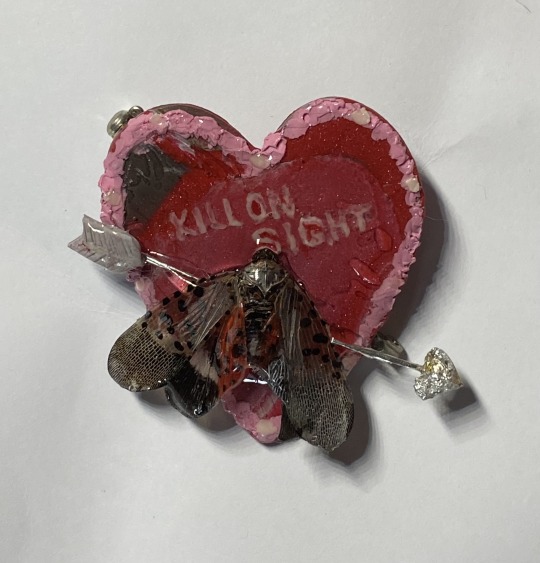
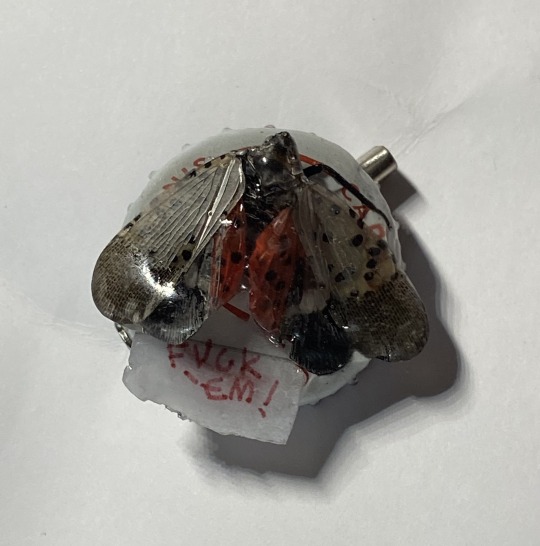

Lantern fly pins :) two lantern flies were harmed in the process of making these ❤️🖤🤍
#spotted lanternfly#lanternflies#lanternfly#Spotted lanternflies#my art#gateau art#commissions open#Bug#invasive species#invasive bugs
5 notes
·
View notes
Video
youtube
Spotted lanternfly eggs are going to hatch any day now.. make sure to scrape em off before they pop, grow up and start sucking the sap out of trees! The egg masses look like a 1" splat of mud, often found on the underside of tree branches. It's smooth in the fall, but looks cracked by the time spring rolls around. Kill these scums before they destroy the planet!
Created by Keith Haskel, the world's #1 Leading Spotted Lanternfly Killer. www.keithhaskel.com
Shot by Brad Hasse.
Drone by Josh Weiss.
6 notes
·
View notes
Text
Shoutout to the old lady in the Target parking lot who reached into her car and pulled out a can of Raid and started spraying as many spotted lanternflies as she could reach. She’s my new hero
1 note
·
View note
Text
What You Need To Know About the Spotted Lanternfly
What is the spotted lanternfly? If you live in Pennsylvania, you have probably already seen this insect. The spotted lanternfly (lycorma delicatula or SLF) is an invasive species native to China and Southeast Asia.
The pest was discovered in Pennsylvania in 2014, specifically Berks County, and has spread throughout Pennsylvania and neighboring states: north to Massachusetts, south to North Carolina, and west to Indiana and Michigan (See the Spotted Lanternfly distribution map for the mid-Atlantic area). The spotted lanternfly feeds on and damages many different plant species.
Many homeowners have reported sightings and damage from this pest, both direct damage by feeding and secondary damage due to excessive sooty mold formation on lanternfly excrement (honeydew). As part of our series on invasive insects, here is what you need to know and what you can do if you spot the colorful insect around your property.
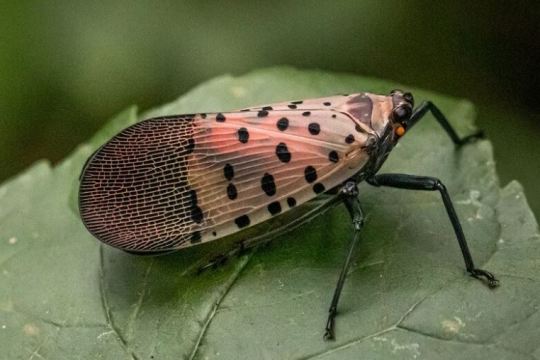
What You Need to Know About the Spotted Lanternfly
As of 2023, the spotted lanternfly is reported to be found in 51 Pennsylvania counties and can build to astounding numbers when left unmanaged. While many Pennsylvania residents have spotted this invasive species on their landscapes, we have some information to help those who want to keep their landscape free from invasive insects.
Appearance
Adult spotted lanternflies can be identified by their coloration and bodies. The insect has grayish wings with black spots; the tips are black and gray, while the bodies are black. When flying, spotted lanternflies will show vibrant red hind wings. Adults are around 1 inch long and a half-inch wide with wings folded. They can jump several feet when startled or approached.
You can also identify the pest via their egg masses or nymph stage. Egg masses are typically found on tree bark on the underside of scaffold branches and occasionally on other smooth surfaces such as rocks, outdoor furniture, and even vehicles. The mass is usually around 1 inch long and a half to three-quarters of an inch wide, with a gray-brown, mud-like covering.
Spotted lanternfly nymphs are much smaller than adults, only about 1/8 to 1/2 an inch long (depending on instar: a phase between two periods of molting in the development of an insect larva or other invertebrate). However, nymphs have distinct coloration: initially black with white spots and wingless, developing red patches/red patches and white spots as they mature.
Behavior & Problems
Spotted lanternflies feed on plant sap, and at a high population, this can cause significant damage to an area’s plant life. While known to feed on over 70 different plants, spotted lanternflies have strongly preferred the tree of heaven (ailanthus altissima), grapevines, maple trees, black walnut, birch, willow, and styrax.
Feeding on tree and plant sap can cause wilting, leaf curling, and dieback. In addition, as the SLF feeds on plant sap, the insect excretes a sugary substance called “honeydew,” which can attract bees, wasps, and other insects, and promotes the growth of sooty mold, which causes further damage to plants.
Here are the months each life stage occurs to help you better identify the plant pest on your property.
Egg masses: The invasive pest usually lays eggs from September to November, and lanternflies spend the winter as eggs.
Nymphs: Nymphs will first hatch around May to June and mature until around July to September.
Adults: July to September is when most spotted lanternflies have matured into adults; mating and egg-laying can continue until December.
The insect has become so prevalent that Pennsylvania has put affected counties under quarantine to stop the movement and slow the insect’s spread to new areas within or out of the current quarantine zone. The quarantine involves traveling and transporting outdoor items.
What You Can Do
If you see any spotted lanternfly or signs of its damage on your property, contact Burkholder Plant Health Care (PHC). Burkholder PHC treats for spotted lanternflies as part of our plant health care program. Our plant health care program emphasizes proper diagnosis and precise treatment, using only state-of-the-art, research-backed methods and equipment. We also utilize various pest management and control processes to protect your landscape from invasive, harmful pests.
Additional Spotted Lanternfly Resources
For more information about spotted lanternfly issues in Pennsylvania, you may wish to visit the following resource links.
Cooperative State Program Homepage
Cooperative State Program Map
Pennsylvania Quarantine Details/Updates
Pennsylvania Quarantine Map
Mid-Atlantic SLF Distribution Map
Contact Burkholder Brothers for Plant Health Care Services
If you want to keep your landscape beautiful, healthy, and free of spotted lanternfly, contact Burkholder PHC for a consultation. Our team of plant health care professionals has decades of experience helping homeowners keep their landscapes as healthy and vibrant as possible. In addition, we have up-to-date knowledge of the latest plant health care methods, from pest control to soil care and more. For more information on our services, contact us today.
Blog is originally published at: https://www.burkholderphc.com/what-you-need-to-know-about-the-spotted-lanternfly/
It is republished with the permission from the author.
0 notes
Text

I’ve made more bugs. They’re friends
#entomology#crochet#amigurumi#stink bug#spotted lanternfly#June bug#bugs#insects#insect#bug#numbers does art
2K notes
·
View notes
Text
i haven't seen any posts about it this summer so im making my own. if you live on the east coast of the US (particularly pennsylvania, new jersey, new york, or maryland) and you see a bug that looks like this:



(and report it to your state's department of agriculture if you're in an area without a known infestation, check here)
spotted lanternflies are pretty, but they're invasive and super destructive, for more info check out your state's department of agriculture !!
4K notes
·
View notes
Text
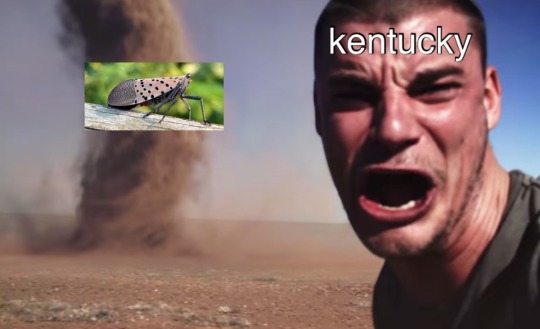
the situation
677 notes
·
View notes
Text
spotted lanternflies, Lycorma delicatula. an infamous invasive in my area, but I’ve come to enjoy these clumsy little freaks more than I ever thought I would.

people are oddly obsessed with destroying them still, although the effect of killing them by hand or even with pesticides is negligible on the now-well-established populations. this is more of a “stop the spread” problem than it is “get rid of established populations,” and it’s people who don’t usually see these who should be on the highest alert for them. still, it’s interesting how their conspicuity, diurnality, and generally slow speed has made them the perfect thing for humans to kill thoughtlessly while other pests stay hidden, like emerald ash borers, or are undeservedly beloved, like honeybees, most of the eastern mantises, and feral cats.
the kill-on-sight campaigns area little depressing to me, especially when directed towards children —sure, they teach invasive species awareness, but really it’s just feeding an ugly desire to kill little animals. not going to ask you to not control them if they’re causing damage to your plants, but the weird bloodthirsty attitude towards Lycorma and declarations of their “evil” nature don’t seem terribly productive. they are as blameless as any invasive species. even when invasives must be killed by the individual (works for some species, not all!), there is still room to act thoughtfully and not demonize an animal for being an animal.
so personally, I let the lanternflies chill—for the most part, they feed on invasive weeds and nonnative ornamental plants, so they’re not much of a concern to me or my garden. whatever proper control methods (parasitoids, pathogens?) get developed probably won’t eliminate all of them, too, so big dumb fulgorids are probably a permanent fixture here. ah, I still feed them to mantises, but the only ones big enough are also invasive…
here’s one all tender and pale after molting. I’d like to find a teneral adult this year, which must be stunning

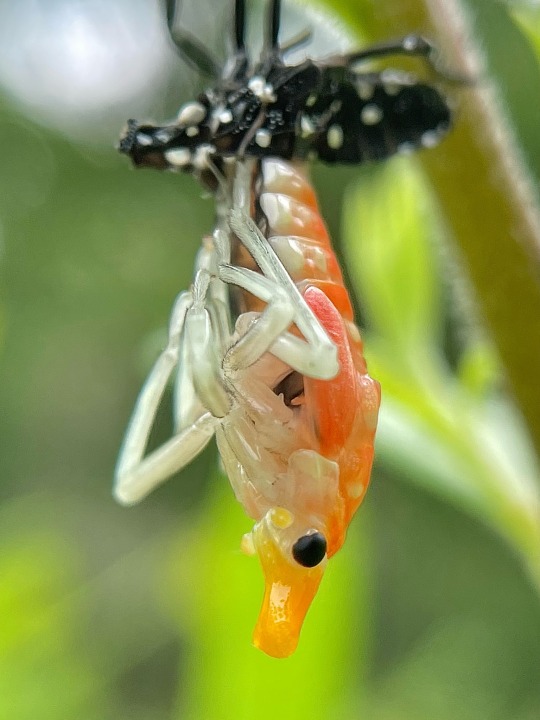
a good post on the topic of killing invasive species by @bowelfly :
797 notes
·
View notes
Text

Bug of the Day
Spotted lanternflies are taking over my life...
#spotted lanternfly#SLF#lanternfly#invasive species#insect#Hemiptera#Fulgoridae#planthopper#Fulgorid planthopper#Lycorma#Lycorma delicatula#bug#BotD#bug of the day
284 notes
·
View notes
Text
@snowbits submitted: I love how goofy spotted lanternflies are, too bad they're invasive
They are such cute funky little dudes! I love them very much. They don't know they're criminals :(
327 notes
·
View notes
Note
Could I suggest a design based off of the spotted lanternfly?

I'm not able to buy designs at the moment, so feel free to put it up as an adopt if you wish!

The Lantern Keeper
No performance goes without the lights illuminating the stage: or, in this case, the flames!
The keeper ensures there is neither too much or too little light present so the viewers may experience the atmosphere of the troupe tent in the best intended ways. The little fire lumaflies dance around the keeper, follow the instructions, rest and charge at the lanters and cast the fire and light at the command. The keeper is never without them or at least a single lantern.
---
Link to the ko-fi in the reblog!
#hollow knight#oc#adoptable#adopts#october design challenge#spotted lanternfly#nightmare troupe#insects#simplified the patterns#but look how cool and cute this bug is irl#I like the concept for this one because lighting is important for stage performance#imagine these fire lumaflies also buzzing behind a big lens that makes a spotlight#among other props above the stage where the keeper flies about and uses them
199 notes
·
View notes
Text

Lantern fly? I Hardly know her! (Rbs>likes, click for higher quality!!)
#my art#commissions open#gateau art#Bug#bug art#bugs#Bug art#insect#insects#beetle#spotted lanternflies#spotted lanternfly#lantern fly#lantern flies
0 notes
Text

My preserved lanternflies are done! This is just a few of them. It's my first time casting resin and I think they turned out well. I'll be sending most of them off to local nature centers so they can be used to help people identity the invasive bugs.
2K notes
·
View notes
Text


If you live in the northeast United States, then you’ve probably seen or at least heard of these guys. The Spotted Lanternfly. Or Lycorma delicatula.
They’ve been rapidly expanding and growing in population and while their presence is too new to know the exact impact they have on our native flora, they seem to pose a major threat to the apple and grape industries. They also excrete a honeydew that leads to mold growth on the plants they feed on.
So the states have put out this message to the public: “If you see it, smush it.”
And while I understand the need to be ruthless in invasive species response, I hope that people aren’t associating all lanternflies with this “bad bug” label.
So right now I’d like to showcase some cool/interesting species of lanternflies (the family name is Fulgoridae) in their native habitats :)

Peanut-Headed Lanternfly (Fulgora laternaria)

No Common Name (Phrictus diadema)
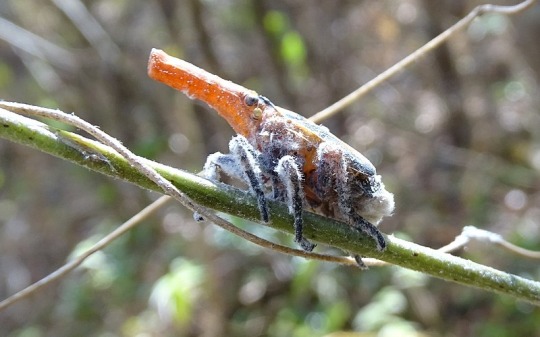
Malagasy Lantern Bug (Zanna madagascariensis)

No Common Name (Pyrops delessertii)
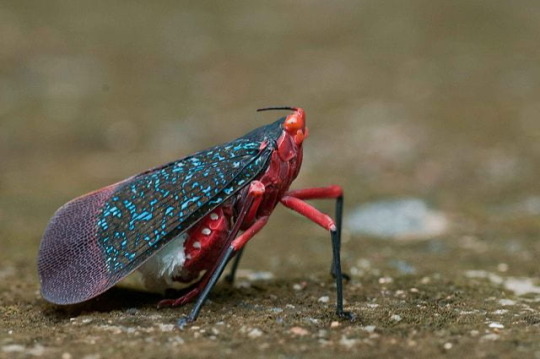
No Common Name (Kalidaysa lanata)
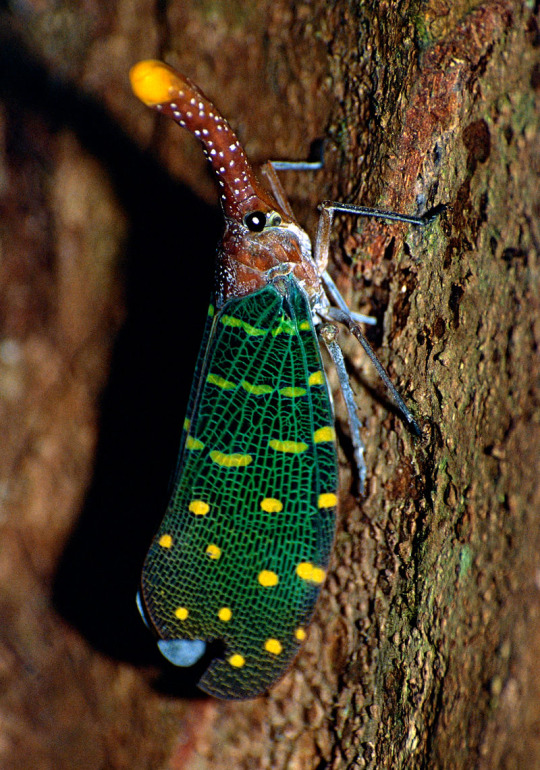
No Common Name (Pyrops intricatus)
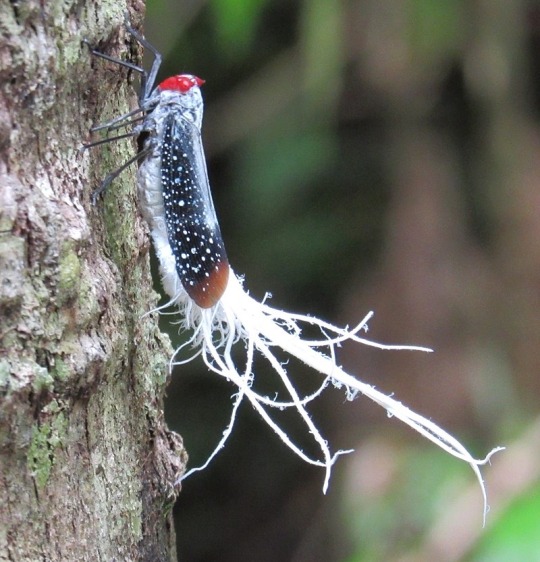
Wax-Tailed Planthopper (Lystra lanata)
Fulgoridae has over 500 species making it a fairly large hemipteran family, please go on a Wikipedia dive to look at all of them. Happy bugging :))
#insects#entomology#bugs#lanternflies#spotted lanternfly#bugblr#planthopper#ecology#invasive species#hemiptera#pretty pretty bugs#i love them all
158 notes
·
View notes
Text
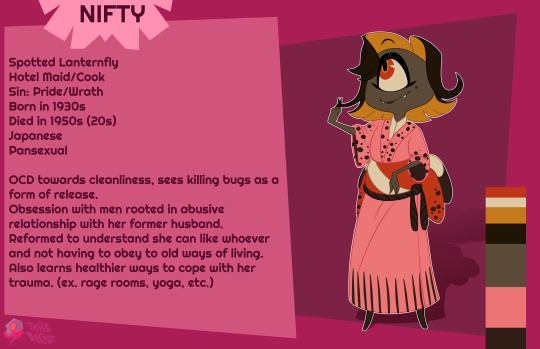
Hehe there's never a pest too big for me to handle!
#ill never forgive what niftys character ended up being like#talism4niac#hazbin hotel#hazbin hotel fanart#hazbin art#hazbin redesign#hazbin rewrite#hazbin hotel redesign#hazbin hotel rewrite#helluverse#demon#furry#furry art#fanart#character art#furry character#clip studio paint#anthropomorphic#furry anthro#nifty#hazbin nifty#hazbin hotel nifty#nifty hazbin hotel#spotted lanternfly#lanternfly
104 notes
·
View notes